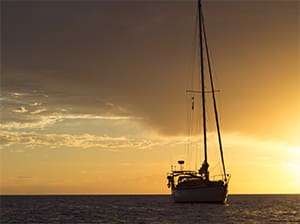Frankly, I am a bit of an experimenter when it comes to anchors. Before setting off on a two-year voyage to Panama and back, I purchased a little-known option to grace my boat’s bow: a Bulwagga. Based on mostly a few vague test reports and the strong testimonial of a friend who was using one, I took a leap of faith, which indicated I had some lingering doubts in the back of my mind about the traditional equipment used in many anchoring dramas. Drama is not something you want when anchoring!
Old faithfuls
First, it has to be recognized that there is a lot more to anchoring than simply tossing over the latest touted design to compensate for your inadequate technique. People like the Hiscocks, the Roths and the Pardeys have managed to blunder around the world many times using the “old faithfuls” like CQR, Danforth and even the Bruce — the last of which I have never had respect for after having personally fended off quite a few boats dragging down or scraping along my sides while supposedly “anchored” with a Bruce. There are those who swear by (instead of at) the Bruce, but it should be noted that they always recommend an enormous size.
I will admit that some anchors are probably great if you are allowed to use twice the weight! However, my wife, who usually lowers the hook, doesn’t agree. Most of us prefer anchors that offer great holding power at a reasonable weight that can be readily handled by a short-handed crew. I was reminded of this in a remote part of the Caribbean when we met a couple on board a large trawler yacht that was in a pickle. Their enormously powerful windlass had packed up and they were unable to haul their 150-pound anchor on board. The nearest possible repairs were more than 200 miles away. A bunch of cruisers formed a human windlass and hauled the anchor up, then wished the couple good luck as they set off for a nonstop trip to safety with only a single chance to anchor if required.
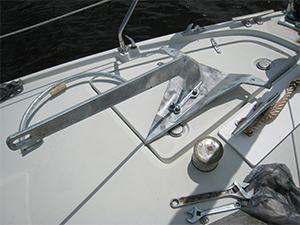 |
|
A Mantus anchor assembled on the foredeck. |
|
John Kettlewell |
A new kid on the block
It is not clear where or when the “new-gen” anchors arrived on the scene. Some will argue that none are really new — only developments of ideas that had been tried previously but are now combined into a new paradigm. In any case, I believe the person who possibly coined the term “new-generation anchors” was Peter Smith of New Zealand, the designer of the original Rocna anchor. He at least popularized the term, and he started a new battle in the anchor wars that have raged since someone tied a rock to a rope and compared it to his friend’s inadequate rock.
My new Mantus anchor came disassembled but was quickly put together with several ordinary bolts, nuts and washers. If nothing else, the sheer genius of creating a take-apart anchor had me nearly won over. One can easily imagine the advantages of being able to stow a disassembled spare down below, or possibly keeping that great big storm anchor somewhere deep in the bowels of the boat for that one time you need it.
Why the Mantus? In addition to the take-apart advantage, the Mantus had all the cool stuff that the new-gen gurus were writing about: a large and scoopy spoon-shaped fluke with a very sharp point, an arched shank and big rollbar designed to always flip the anchor upright into its burying position, and a relatively thin shank to aid deep penetration. It also features strong construction with no hinge, and all sorts of bragged-about geometry that sounded wonderful.
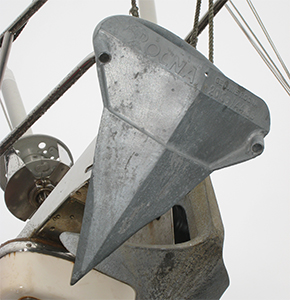 |
|
A new-gen Rocna anchor alongside the classic Bruce anchor. |
|
John Kettlewell |
As someone who has anchored successfully in all weather with anchors designed back in the first half of the 20th century, I am not easily impressed by hype. I had to try for myself. One of my first experiments with the Mantus was on a night with lightish winds, but in the Taunton River with a strong reversing current. We spent the evening anchored with a large fleet watching Fourth of July fireworks off of Fall River, Mass. Most of the boats were on short scope and the best anchoring techniques had not been used in the rush to get to the beer coolers. Of course, the wind picked up after dark around the same time the current reversed and the two forces opposed each other. The anchorage became a mess of boats of all sizes and types spinning in all directions with crews pulling up dragging anchors. Through it all, the Mantus stayed put with no fuss, though we too had anchored in haste with little thought to setting for a blow. A modest test, but good to know.
Subsequently, we have Mantused our way around Southeast New England for several years, testing the anchor out in a variety of familiar places where we have anchored many times with the barbarians using old-gen equipment. Cuttyhunk is one of my favorite spots. We know the harbor, the bottom and how anchors perform there. I have anchored inside hundreds of times — it’s easy because I just drop my anchor in the same hole I have been using for decades! In reality, it can be a challenging anchorage due to many weedy areas, almost never enough room to let out adequate scope, changing winds that can reverse in the middle of the night unexpectedly and the proximity of numerous other boats that may not be all that familiar with the particulars of how to properly use ground tackle. In this anchorage we have been T-boned in the night by a dragging four-boat raft up, we have anchored through numerous gales, tropical storms and Hurricane Bob, and we have tested many popular anchor types: Danforth, Fortress, CQR, Bulwagga and now Mantus.
Though we anchored routinely with the Mantus for several years before getting caught in a big blow, the first real test came in the Columbus Day weekend gale of 2016. It wasn’t a survival storm, but we had solid 40-knot winds with higher gusts for many hours. The Mantus held firm with no dragging and no fuss, though our anchor chain snubber line did break in the middle of the night. It was the first time that had ever happened, indicating it was a pretty good test of our anchoring gear.
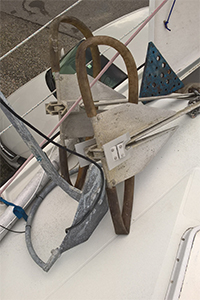 |
|
Two Danforth anchors and a Rocna on a foredeck. |
|
John Kettlewell |
The devil is in the details
Since that experience, and after numerous other minor blows, I have gained tremendous confidence in my new-gen anchor. But why is it better than my old CQRs and other traditional gear?
First, that very sharp point definitely aids penetration, especially if the bottom is weedy or a bit hard. We always lower the anchor carefully until it reaches the bottom. We then let out chain gradually, with periodic snubbing as the boat drifts back on the wind. Very soon after getting our new anchor, we noticed something different in this process. Almost from the time the anchor is on the bottom, there is a solid bite. There is never any squishy feeling like you often get as a plow-type anchor does its thing and plows along the bottom. The Mantus just penetrates right away. Because of this, it is not a good idea to dump the anchor and chain and then let the boat fly downwind until it comes to a sudden and abrupt halt — you might break something!
The second thing we noticed early on with the Mantus is that there is a slight possibility of fouling the anchor by dumping it abruptly to the bottom, allowing the chain to loop under and catch on one of the “ears” where the big hoop is bolted to the anchor. It doesn’t happen often, but we have managed to foul the anchor a couple times. Once you get used to the usual solid and early bite the anchor makes, you will be able to tell if something is wrong because, if it is, you get that squishy feeling from the old plow anchor days. Other anchors with hoops, like Rocnas and Mansons, do not have bolt-on hoops and would not suffer from this problem.
Despite the early and strong bite these anchors make, we still try to lay out adequate scope of at least 5:1 with all chain, or more if there is a big blow. However, many times I have had to shorten things up in places like Cuttyhunk as the harbor fills up and others begin to crowd around. I feel pretty secure on as little as 3:1 in ordinary wind conditions, and we have never dragged once the anchor has been set in a mud bottom. Set it by backing down hard at 5:1 scope and you can almost immediately shorten things up if you need to. We have also used the Mantus in sandy mud, shelly conditions, smallish rocks and extreme weed with good success. This is a truly universal anchor, though I can’t claim experience in pure sand like what is found in the Bahamas and Caribbean.
The aforementioned hoop on the Mantus is larger than on some other new-gen anchors. I am not certain, but it seems this aids in shedding mud and weeds when weighing anchor. The large scoop-shaped flukes on these anchors tend to bring up a big ball of muck and junk at times, and I have noticed that some of the non-Mantus designs are a bit harder to clean in this regard. The bigger hoop means there is more space between the hoop and the flukes.
A bonus with the hoop design is that it makes for the perfect handle to use when manhandling the anchor off and on the bow roller or moving it around deck. The lack of a hinge between the shank and the head, like the CQR uses, also makes the anchor much easier to physically move around. The hinged designs always flop one way or the other, inevitably pinching fingers and banging shins.
The thin shank of the Mantus definitely does aid in penetration when compared to some thick-shanked designs like the old CQR. I have observed both anchor types when on the bottom, and the CQR shank was often on its side and not really buried, while the Mantus does tend to roll upright and dig downward. Strangely, despite burying well, I have found that when you are retrieving the anchor it comes out of the bottom much more easily once the boat is right over it. After a big blow, it would sometimes take an hour or more to pull out a CQR and I have spent half a day pulling Fortress and Danforth anchors out of the bottom. Not so with the Mantus.
Another touted feature that we have proven in real-world testing is the amazing ability of new-gen hooks to reset when the wind shifts. Cuttyhunk is notorious for sudden shifts in the middle of the night when a land breeze overwhelms the prevailing sea breeze. We have been through many 2 a.m. anchoring drills when a zephyr of a southwest wind turns into a honking blast of northeast off the land. Needless to say, the many boats on short scope due to inadequate room and poor technique often go whistling away in the dark. If possible, we try to anchor with nobody behind us for this very reason.
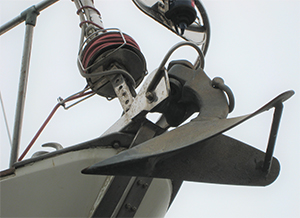 |
|
Another widely used anchor: the Plow or CQR. |
|
John Kettlewell |
In any case, we have found that even these complete reversals in a matter of moments are handled well by the Mantus. We’ve also been through quite a few big thunderstorms with winds clocking around from all directions, often more than once — no problem! These new-gen hooks just reset with the clever combination of the big hoop keeping the pointy end pointed down, the sharp point aiding quick penetration and the thin but stiff shank with no hinge forcing the anchor to rotate to face the new direction.
Another new-gen anchor that doesn’t use a hoop, the Spade, gets away with it by having a very heavily weighted tip that makes sure the point stays down. Though I have no direct experience with a Spade, I have observed several anchoring upwind of me and they seem to do well overall, with only one or two dragging incidents observed. I’m not sure if the point and head area is a bit too blunt for weedy bottoms, or maybe the lack of a hoop makes penetration iffier. There are not a lot of Spade anchors to compare to the hoop types, so it is harder to draw conclusions.
Anchoring perfection?
About the biggest negative factor with the Mantus is that it doesn’t fit on my bow roller arrangement all that well, at least compared to the traditional anchors that existed when the boat was built. The long thin shank reaches a bit further back and doesn’t allow me to easily snug the anchor up tight to the roller. I remove the anchor and wedge the hoop into my bow pulpit at times to prevent the anchor from bashing around; at other times I lash it in place. However, I suspect it would fit well on a roller arrangement that was designed for a fixed-shank plow anchor.
You might be tempted to try a new-gen anchor that is one size smaller than your old-gen, but I don’t see the point. If your anchoring windlass and other gear is sized for a 45-pounder, you might as well use a 45-pound new-gen and gain extra holding power. It’ll rarely be needed, but it’ is nice to know it’s there.
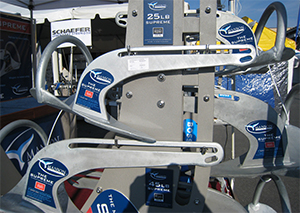 |
|
Manson anchors on display at the Annapolis Boat Show. |
|
John Kettlewell |
If you need something lighter, carry a couple of smaller Fortress aluminum hooks. They are not really “new-gen” anchors since they are refined versions of the older steel Danforth anchors. In many independent tests, the Danforth and Fortress pattern anchors offer the most holding power per pound in straight-line pulls (when properly dug in). They make fantastic secondary anchors for when you need to kedge a boat off the ground or create a Bahamian moor, or for rowing out in the dinghy when a big blow is suspected. However, they do not reset reliably in big wind shifts and they are more finicky to set. They are also very difficult to retrieve once they’ve been buried after a big blow and are notoriously bad in most weedy bottoms. A belt-and-braces approach to anchoring is to carry more than one type of anchor for different conditions, and the Fortress is a great complement to a new-gen main anchor.
Bottom line
Binocular peeping has convinced me that when someone is anchoring upwind, I want them to be using a hoopy new-gen anchor; however, I can understand the reluctance to give up on a tried-and-true old friend that you have dragged around anchorages all over the world. There are several different brands and types of new-gen anchors, but I don’t think you can go wrong with one of the popular hooped designs. I have observed good performance from Mantus, Rocna, Spade and Manson. The Knox is another interesting design from a Scottish company. I’m sure there are others equally as good or better, but you may want to start your new-gen experiments with one that has a well-known track record. Choose one that fits your boat, your eye and your wallet, and give it a go!
John J. Kettlewell is a voyager, writer, photographer and the author of The Intracoastal Waterway Chartbook.

